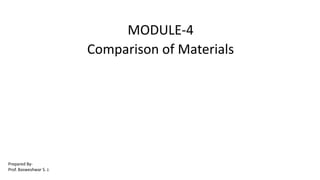Module IV MATERIAL TESTING AND EVALUATION [BTCVE506A]
- 1. MODULE-4 Comparison of Materials Prepared By- Prof. Basweshwar S. J.
- 2. Comparison of Materials Stages- ŌĆó According to their phases ŌĆó According to their internal structure & chemical composition Prepared By- Prof. Basweshwar S. J.
- 3. ŌĆó Phases- Gases : Air, oxygen, CO2 Liquids : Water, chemical admixtures Semi-solids : Fresh pastes, mortars, asphalt Solids : Metals, hardened concrete Prepared By- Prof. Basweshwar S. J.
- 4. ŌĆó Internal structure & chemical composition One of the most important task of an engineer is to select the most suitable material for a given civil engineering structure. Prepared By- Prof. Basweshwar S. J.
- 5. Factors Determining the Choice of Proper Material for a Structure- Strength, rigidity & Durability Requirements Permanent loading ŌåÆ Creep Strength Repeated loading ŌåÆ Fatigue Strength Impact loading ŌåÆ Toughness & Resilience Surface loading ŌåÆ Hardness & Resistance to abrasion Environmental Requirements ŌĆō Temperature change ŌåÆ coefficient of thermal conductivity ŌĆō Moisture movement ŌåÆ permeability ŌĆō Chemical effects ŌåÆ chemical composition Prepared By- Prof. Basweshwar S. J.
- 6. Factors Determining the Choice of Proper Material for a Structure- Economy. Choose the cheaper & available materials considering ŌĆó Initial cost ŌĆó Useful life ŌĆó Frequency of maintenance ŌĆó Cost of maintenance ŌĆó Salvage value ŌĆó Comfortability Prepared By- Prof. Basweshwar S. J.
- 7. ENVIRONMENTAL IMPACT Prepared By- Prof. Basweshwar S. J.
- 8. ENVIRONMENTAL IMPACT Prepared By- Prof. Basweshwar S. J.
- 9. HEALTH AND SAFETY. Prepared By- Prof. Basweshwar S. J.
- 10. HEALTH AND SAFETY. Prepared By- Prof. Basweshwar S. J.










